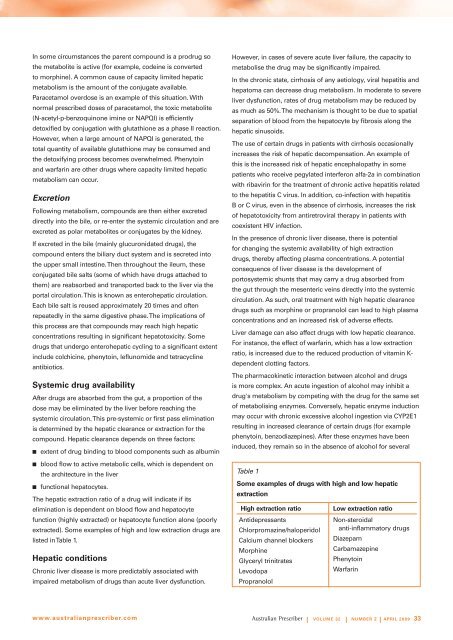Prescribing in liver disease - Australian Prescriber
Prescribing in liver disease - Australian Prescriber
Prescribing in liver disease - Australian Prescriber
You also want an ePaper? Increase the reach of your titles
YUMPU automatically turns print PDFs into web optimized ePapers that Google loves.
In some circumstances the parent compound is a prodrug so<br />
the metabolite is active (for example, code<strong>in</strong>e is converted<br />
to morph<strong>in</strong>e). A common cause of capacity limited hepatic<br />
metabolism is the amount of the conjugate available.<br />
Paracetamol overdose is an example of this situation. With<br />
normal prescribed doses of paracetamol, the toxic metabolite<br />
(N-acetyl-p-benzoqu<strong>in</strong>one im<strong>in</strong>e or NAPQI) is efficiently<br />
detoxified by conjugation with glutathione as a phase II reaction.<br />
However, when a large amount of NAPQI is generated, the<br />
total quantity of available glutathione may be consumed and<br />
the detoxify<strong>in</strong>g process becomes overwhelmed. Phenyto<strong>in</strong><br />
and warfar<strong>in</strong> are other drugs where capacity limited hepatic<br />
metabolism can occur.<br />
Excretion<br />
Follow<strong>in</strong>g metabolism, compounds are then either excreted<br />
directly <strong>in</strong>to the bile, or re-enter the systemic circulation and are<br />
excreted as polar metabolites or conjugates by the kidney.<br />
If excreted <strong>in</strong> the bile (ma<strong>in</strong>ly glucuronidated drugs), the<br />
compound enters the biliary duct system and is secreted <strong>in</strong>to<br />
the upper small <strong>in</strong>test<strong>in</strong>e. Then throughout the ileum, these<br />
conjugated bile salts (some of which have drugs attached to<br />
them) are reabsorbed and transported back to the <strong>liver</strong> via the<br />
portal circulation. This is known as enterohepatic circulation.<br />
Each bile salt is reused approximately 20 times and often<br />
repeatedly <strong>in</strong> the same digestive phase. The implications of<br />
this process are that compounds may reach high hepatic<br />
concentrations result<strong>in</strong>g <strong>in</strong> significant hepatotoxicity. Some<br />
drugs that undergo enterohepatic cycl<strong>in</strong>g to a significant extent<br />
<strong>in</strong>clude colchic<strong>in</strong>e, phenyto<strong>in</strong>, leflunomide and tetracycl<strong>in</strong>e<br />
antibiotics.<br />
Systemic drug availability<br />
After drugs are absorbed from the gut, a proportion of the<br />
dose may be elim<strong>in</strong>ated by the <strong>liver</strong> before reach<strong>in</strong>g the<br />
systemic circulation. This pre-systemic or first pass elim<strong>in</strong>ation<br />
is determ<strong>in</strong>ed by the hepatic clearance or extraction for the<br />
compound. Hepatic clearance depends on three factors:<br />
n extent of drug b<strong>in</strong>d<strong>in</strong>g to blood components such as album<strong>in</strong><br />
n blood flow to active metabolic cells, which is dependent on<br />
the architecture <strong>in</strong> the <strong>liver</strong><br />
n functional hepatocytes.<br />
The hepatic extraction ratio of a drug will <strong>in</strong>dicate if its<br />
elim<strong>in</strong>ation is dependent on blood flow and hepatocyte<br />
function (highly extracted) or hepatocyte function alone (poorly<br />
extracted). Some examples of high and low extraction drugs are<br />
listed <strong>in</strong> Table 1.<br />
Hepatic conditions<br />
Chronic <strong>liver</strong> <strong>disease</strong> is more predictably associated with<br />
impaired metabolism of drugs than acute <strong>liver</strong> dysfunction.<br />
However, <strong>in</strong> cases of severe acute <strong>liver</strong> failure, the capacity to<br />
metabolise the drug may be significantly impaired.<br />
In the chronic state, cirrhosis of any aetiology, viral hepatitis and<br />
hepatoma can decrease drug metabolism. In moderate to severe<br />
<strong>liver</strong> dysfunction, rates of drug metabolism may be reduced by<br />
as much as 50%. The mechanism is thought to be due to spatial<br />
separation of blood from the hepatocyte by fibrosis along the<br />
hepatic s<strong>in</strong>usoids.<br />
The use of certa<strong>in</strong> drugs <strong>in</strong> patients with cirrhosis occasionally<br />
<strong>in</strong>creases the risk of hepatic decompensation. An example of<br />
this is the <strong>in</strong>creased risk of hepatic encephalopathy <strong>in</strong> some<br />
patients who receive pegylated <strong>in</strong>terferon alfa-2a <strong>in</strong> comb<strong>in</strong>ation<br />
with ribavir<strong>in</strong> for the treatment of chronic active hepatitis related<br />
to the hepatitis C virus. In addition, co-<strong>in</strong>fection with hepatitis<br />
B or C virus, even <strong>in</strong> the absence of cirrhosis, <strong>in</strong>creases the risk<br />
of hepatotoxicity from antiretroviral therapy <strong>in</strong> patients with<br />
coexistent HIV <strong>in</strong>fection.<br />
In the presence of chronic <strong>liver</strong> <strong>disease</strong>, there is potential<br />
for chang<strong>in</strong>g the systemic availability of high extraction<br />
drugs, thereby affect<strong>in</strong>g plasma concentrations. A potential<br />
consequence of <strong>liver</strong> <strong>disease</strong> is the development of<br />
portosystemic shunts that may carry a drug absorbed from<br />
the gut through the mesenteric ve<strong>in</strong>s directly <strong>in</strong>to the systemic<br />
circulation. As such, oral treatment with high hepatic clearance<br />
drugs such as morph<strong>in</strong>e or propranolol can lead to high plasma<br />
concentrations and an <strong>in</strong>creased risk of adverse effects.<br />
Liver damage can also affect drugs with low hepatic clearance.<br />
For <strong>in</strong>stance, the effect of warfar<strong>in</strong>, which has a low extraction<br />
ratio, is <strong>in</strong>creased due to the reduced production of vitam<strong>in</strong> K-<br />
dependent clott<strong>in</strong>g factors.<br />
The pharmacok<strong>in</strong>etic <strong>in</strong>teraction between alcohol and drugs<br />
is more complex. An acute <strong>in</strong>gestion of alcohol may <strong>in</strong>hibit a<br />
drug's metabolism by compet<strong>in</strong>g with the drug for the same set<br />
of metabolis<strong>in</strong>g enzymes. Conversely, hepatic enzyme <strong>in</strong>duction<br />
may occur with chronic excessive alcohol <strong>in</strong>gestion via CYP2E1<br />
result<strong>in</strong>g <strong>in</strong> <strong>in</strong>creased clearance of certa<strong>in</strong> drugs (for example<br />
phenyto<strong>in</strong>, benzodiazep<strong>in</strong>es). After these enzymes have been<br />
<strong>in</strong>duced, they rema<strong>in</strong> so <strong>in</strong> the absence of alcohol for several<br />
Table 1<br />
Some examples of drugs with high and low hepatic<br />
extraction<br />
High extraction ratio<br />
Antidepressants<br />
Chlorpromaz<strong>in</strong>e/haloperidol<br />
Calcium channel blockers<br />
Morph<strong>in</strong>e<br />
Glyceryl tr<strong>in</strong>itrates<br />
Levodopa<br />
Propranolol<br />
Low extraction ratio<br />
Non-steroidal<br />
anti-<strong>in</strong>flammatory drugs<br />
Diazepam<br />
Carbamazep<strong>in</strong>e<br />
Phenyto<strong>in</strong><br />
Warfar<strong>in</strong><br />
www.australianprescriber.com<br />
| Volume 32 | NUMBER 2 | APRIL 2009 33
















